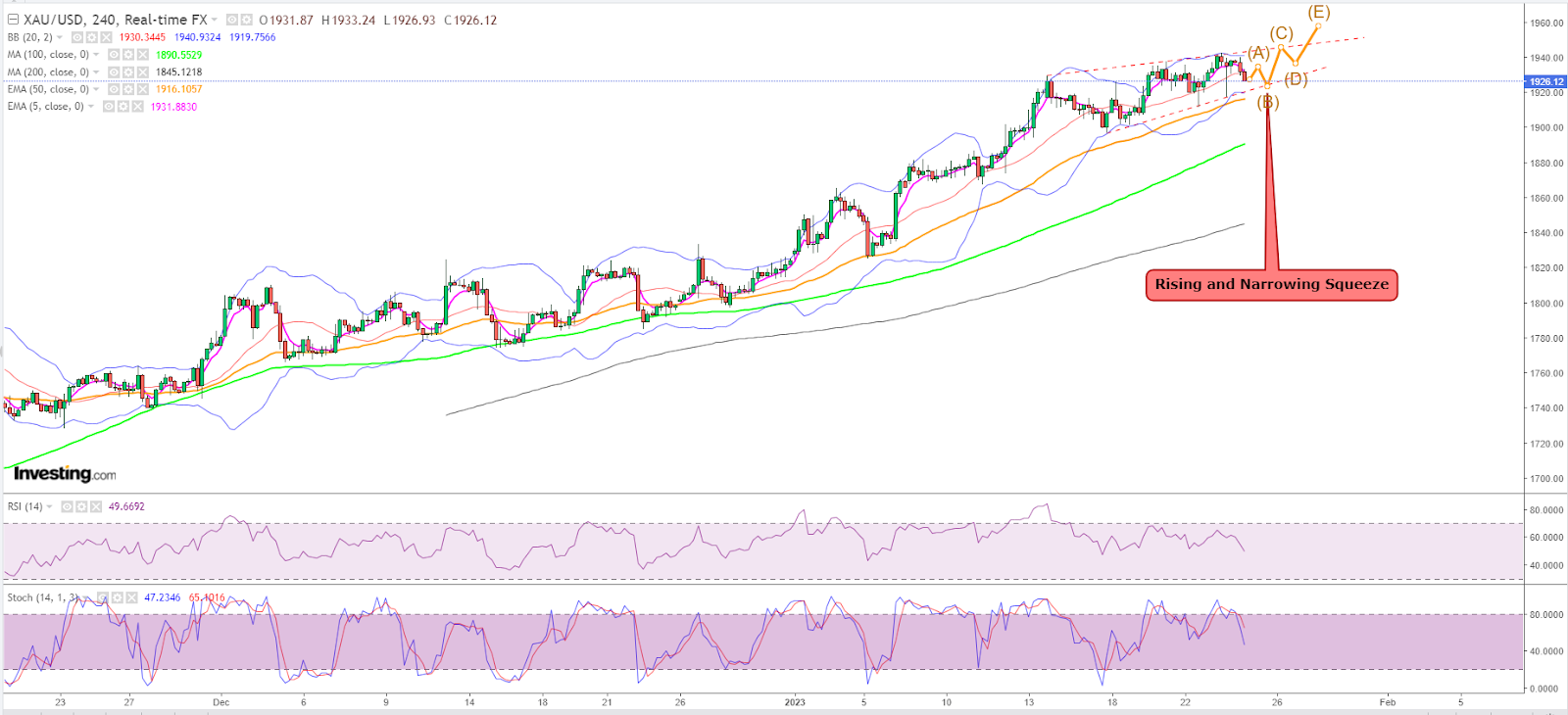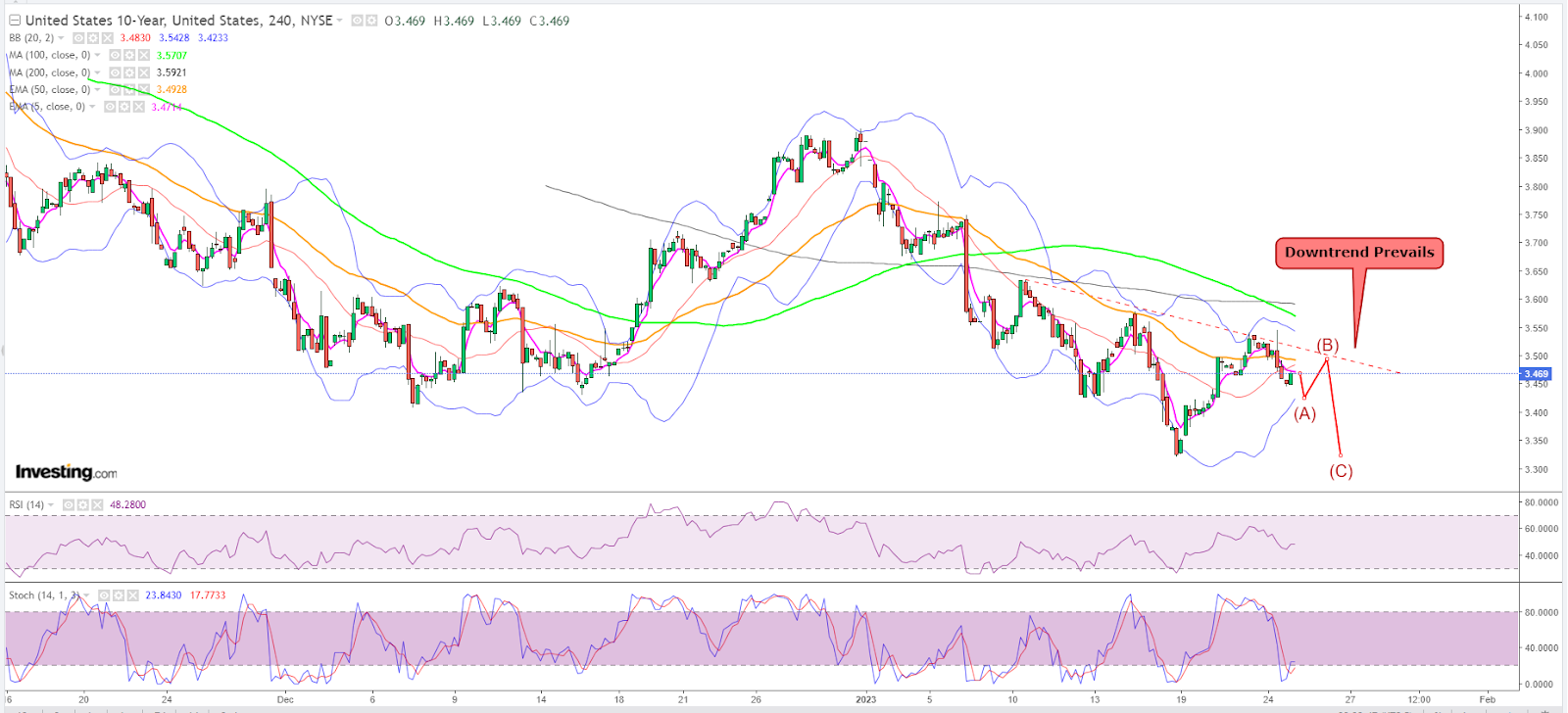- Gold has missed the $1,950 target by less than $10 twice this week
- If Friday’s PCE Index shows a meaningful inflation drop, gold could be 3rd time lucky
- Dollar, bond yields need to be aligned lower, too, for gold to get to $1,950 and beyond
Gold has come within $10 of breaching the $1,950 resistance back-to-back in the past two sessions. The third test or successful breach could likely come Friday when the PCE Index provides the latest update on US inflation.
The question is whether the dollar and Treasury yields will be aligned to support the test for gold and form a solid berth for it to move beyond $1,950.
Gold has virtually been a one-way trade over the past three months, rising from October’s closing level of $1,640.70 on COMEX futures to its latest settlement of $1926.12, as the dollar and yields tumbled on bets of smaller US rates this year versus 2022.
Charts by SKCharting.com, with data powered by Investing.com
Under ordinary circumstances, gold would be a hedge against inflation. Investors buy it as a store of value against the dollar, which typically erodes in value when prices of goods and services go up.
However, what the US economy is experiencing now is nowhere near ordinary as bets that the Federal Reserve will downsize — and eventually pause — rate hikes this year have become the No. 1 trade across markets.
That has put gold at the center of macro market attention. Every dollar and yield dip has become an opportunity to bid the yellow metal higher. Data on cooling inflation has, thus, become gold’s best ally versus the soaring prices of goods and services that used to make a case for buying the precious metal.
While the Consumer Price Index, or CPI, is the broader inflation benchmark for America and the world, Friday’s PCE Index, which is a reading on personal consumption expenditures, happens to be the Fed’s preferred inflation gauge. That makes it just as important in deciding gold’s immediate direction.
The Fed particularly looks at the “core” component of the PCE data that presents a “cleaner” read on inflation by stripping out volatile food and energy prices. Wall Street economists have been fairly accurate with their forecasts on core year-on-year PCE growth. In October and November, their consensus was for a growth of 5.0% and 4.7% year-on-year, respectively — exactly what the Commerce Department reported. For the December data due on Friday, the expectation is for a growth of 4.4%. If correct, it would be the lowest annual reading on core inflation since October 2021.
In a bid to control surging prices, the Fed added 425 basis points to US interest rates since March via seven rate hikes. Prior to that, interest rates peaked at just 25 basis points, as the central bank slashed them to nearly zero after the global COVID-19 outbreak in 2020. The Fed, which executed four back-to-back jumbo rate hikes of 75 basis points from June through November, imposed a more modest 50-basis point increase in December.
For its next rate decision on Feb. 1, economists expect the central bank to announce an even smaller hike of 25 basis points. The last time the Fed announced a 25 basis-point increase was in March 2022, at the start of its current rate hike cycle.
Analysts on the ForexLive forum said in a note earlier this week that the PCE “will inform expectations for the Fed’s February meeting, where a 25 bps rate hike is expected.”
But if other material data within the PCE Index suggested that inflation remains sticky, then the Fed might have second thoughts about slowing rate hikes further in February, said analysts at Credit Suisse (SIX:CSGN). “If there is an upside surprise within the PCE data, then pricing for 50-bps could pick up once again,” they said in a note.
Aside from the PCE data, the preliminary reading for the 4th quarter US Gross Domestic Product, due on Thursday, could be another factor deciding gold’s direction toward $1,950, though it is expected to have a lesser degree of influence than the inflation number. For what it’s worth, GDP is expected to have grown by just 2.6% in the final quarter of 2022 versus 3.2% in the third quarter — another potentially bullish element for gold, which also thrives on any weakness in the US economy.
Gold prices have become more volatile in January than in the past two months, but they have barely lost their upward momentum, suggesting that bulls in the space are betting heavily on a 25-bps hike on Feb. 1.
Over the past 48 hours, gold futures narrowly missed making a widely-expected breach of the $1,950 resistance, hitting a session high of $1,943.80 on Monday and an intraday peak of $1,940.65 on Tuesday.
Forecasters are anticipating gold to hit $1,970 and $2,000 soon, en route to what many believe will be a new high overwriting the August 2020 record of $2,078 on COMEX and $2,064.52 in spot gold,
Commodities strategists at TD (TSX:TD) Securities said the “bar is low” for hedge funds in gold to catalyze yet another buying program. “However, algo trading flows are expected to remain limited with substantial purchases only likely above the $1,970 range.”
Nick Cawley, a precious metals strategist who blogs on DailyFX, said this week’s two heavyweight US data releases — referring to the PCE and GDP numbers — could set gold on track to its return to $2,000 pricing. “Both have the potential to move the US dollar sharply” lower, he suggested.
So, where should the dollar be over the next 24 hours to help get gold beyond its $1,950 target? The Dollar Index Futures hit a low of 101.545 in Wednesday’s pre-US session.
Said Sunil Kumar Dixit, chief technical strategist at SKCharting.com:
“DX needs to stay under 102 in order to continue [the] bearish trail. A temporary retest of 102 and rejection followed by breach of 101.38 support may push DX lower towards 101 and perhaps 100.70 to set stage for gold hitting $1,956-$1,968 and even $1,972.”
On yields, the benchmark US 10-year note hit a low of 3.447% in Wednesday’s pre-US session. Dixit said they need to come down to 3.30%.
“Yields’ temporary bounce toward 3.50-3.55% may be short-lived, to be followed by a retreat and break below the 3.45% level. That could bring yields to 3.40-3.35%, even 3.30%, which would be conducive for $1,950-$1,970 gold.”

As for gold itself, the spot price could immediately peak at $1,972, said Dixit.
“Tuesday’s swift move towards the $1,942 resistance and $1,917 support, followed by a settlement above $1,936 shows affirmation of bullish continuation that targets $1,968 and $1,972 mainly.
The minor move range will be $1,952-$1,917, with $1,930-$1,935 being the mid range.”
He also pointed out that it was critically important that gold hold above the $1,920-$1,917 support to maintain its uptrend. “If this support fails, a drop to $1,900 and $1,880 will begin.”
Disclaimer: Barani Krishnan uses a range of views outside his own to bring diversity to his analysis of any market. For neutrality, he sometimes presents contrarian views and market variables. He does not hold positions in the commodities and securities he writes about.
